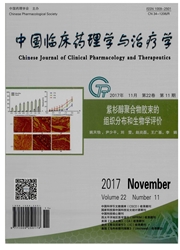

 中文摘要:
中文摘要:
目的:观察地塞米松对慢性心衰大鼠心肌中内皮素(ET)信号通路的过度激活与氧化应激的干预作用。方法:雄性SD大鼠,通过冠脉结扎6周造成慢性心衰模型。分为慢性心衰组、地塞米松组,另设假手术组作为阴性对照。地塞米松组动物在饮水中按1μg/mL的浓度给予地塞米松治疗。连续治疗6周后,取心脏进行Masson三色法染色,以检测心肌纤维化;RT-PCR法检测心肌组织中ETA受体、NF-κB和一氧化氮合酶(iNOS)的基因表达水平。结果:与假手术组相比,慢性心衰组大鼠心肌纤维化显著,地塞米松能有效改善心衰大鼠心肌组织的纤维化;心衰大鼠心肌组织中ETA受体、NF-κB和iNOS的基因表达水平明显上调,而地塞米松可使心衰大鼠心肌中ETA受体、NF-κB和iNOS的基因表达水平显著下调。结论:地塞米松通过下调ETA受体,抑制ET信号通路的过度激活和抗氧化作用,有效改善慢性心衰大鼠的心肌纤维化。
 英文摘要:
英文摘要:
AIM: To investigat over-activated endothelin (ET) signaling and oxidative stress in chronic heart failure (CHF) rats and dexamethasone intervention. METHODS: Rats were performed left coronary artery ligation for 6 weeks to develop CHF and treated with dexamethasone. Masson' s trichrome was used to measure myocardial fibrosis, mRNA expression of endothelin A receptor (ETAR), NF-κB and inducible nitric oxide synthase (iNOS) in myocardium were performed. RESULTS: Myocardial fibrosis was more obvious in CHF group than that in sham operation group. Dexamethasone treatment ameliorated interstitial fibrosis in myocardium of CHF rats. mRNA expression of ETAR, NF-κB and iNOS in myocardium of CHF rats was significantly upregulated compared with sham operation group, and dexamethasone down-regulated the mRNA expression of ETAR, NF-κB and iNOS. CONCLUSION: Dexamethasone inhibits over-activated ET signaling and oxidative stress in CHF myocardium through the down-regulated ETAR, which attenuate myocardial fibrosis.
 同期刊论文项目
同期刊论文项目
 同项目期刊论文
同项目期刊论文
 Abrupt changes in FKBP12.6 and SERCA2a expression contribute to sudden occurrence of ventricular fib
Abrupt changes in FKBP12.6 and SERCA2a expression contribute to sudden occurrence of ventricular fib Improvement of chronic heart failure by dexamethasone is not associated with downregulation of lepti
Improvement of chronic heart failure by dexamethasone is not associated with downregulation of lepti Upregulation of leptin pathway correlates with abnormal expression of SERCA2a,
phospholamban and the
Upregulation of leptin pathway correlates with abnormal expression of SERCA2a,
phospholamban and the Down-regulation of FKBP12.6 and SERCA2a contributes to acute heart failure in septic shock and is re
Down-regulation of FKBP12.6 and SERCA2a contributes to acute heart failure in septic shock and is re CPU0213 , a novel endothelin receptor antagonist, relieves hypoxic pulmonary hypertension in rats by
CPU0213 , a novel endothelin receptor antagonist, relieves hypoxic pulmonary hypertension in rats by 期刊信息
期刊信息
